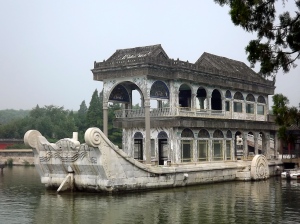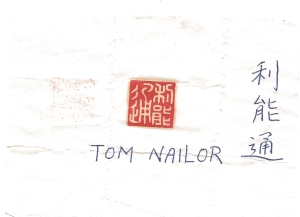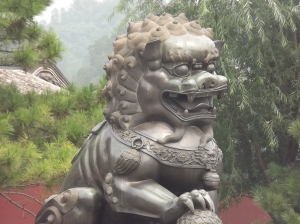 The biting claws and fearsome teeth of the Chinese lion-dog, sometimes called both Guardian Lions and Foo Dogs seemed designed merely to ward off intruders. But I am surprised to discover that, like so many other things here in China, there is a duality: the male, on the right as you walk in, has his claw perched on a ball, representing the globe and the world. The female, on the opposite side, seems poised to maul something, but is actually cuddling with
The biting claws and fearsome teeth of the Chinese lion-dog, sometimes called both Guardian Lions and Foo Dogs seemed designed merely to ward off intruders. But I am surprised to discover that, like so many other things here in China, there is a duality: the male, on the right as you walk in, has his claw perched on a ball, representing the globe and the world. The female, on the opposite side, seems poised to maul something, but is actually cuddling with 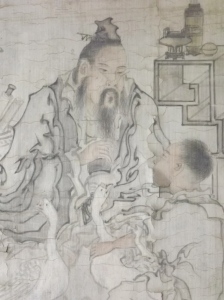 a smaller version of herself, representing the mothering image, the protection of the young and the helpless. Such an iconic piece, and one that seems to flank everything from ancient temples to factories here in China. The Summer Palace, known in China as Yiheyuan, was built originally in the Qing dynasty, and has experienced various rebuilding projects over the centuries. It was originally designed for a Chinese Empress, and is a beautiful place to walk through.
a smaller version of herself, representing the mothering image, the protection of the young and the helpless. Such an iconic piece, and one that seems to flank everything from ancient temples to factories here in China. The Summer Palace, known in China as Yiheyuan, was built originally in the Qing dynasty, and has experienced various rebuilding projects over the centuries. It was originally designed for a Chinese Empress, and is a beautiful place to walk through.
The buildings are iconic Chinese style, with the sloping tile roofs and the distinctive levels, despite their recent construction. There are a number of beautiful paintings featuring scenes from Chinese legend and history, and it 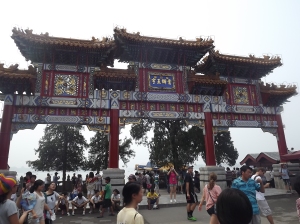 was all I could do to keep up as we strolled down the Changlang (Long Corridor). There were numerous other beautiful sights, such as a glass-topped table on which the Emperor’s mother would eat while watching goldfish swim beneath her plates, or perhaps stare out at the beautiful blooms that seem to adorn every tree.
was all I could do to keep up as we strolled down the Changlang (Long Corridor). There were numerous other beautiful sights, such as a glass-topped table on which the Emperor’s mother would eat while watching goldfish swim beneath her plates, or perhaps stare out at the beautiful blooms that seem to adorn every tree.
We came out beside the Kunming Lake, where the morning fog rolled across and paddle-boats puttered alongside men pushing their way across in longer ships. Stealing the scene was the impressive but somewhat foolish Marble Boat: the boat is actually wooden painted to look like Marble, but is reviled because its opulence was built using Imperial funds that were intended for the Chinese navy. We passed this beautiful folly and boarded  a Dragon Boats for a ride around the lake—the boat itself was a bit tacky, but made up for by the company. We met some Ethiopian men who had been living in China for almost a year, and seemed as eager as anyone else to have a photo with us, and they were sure to give us tips about things to try while we were here.
a Dragon Boats for a ride around the lake—the boat itself was a bit tacky, but made up for by the company. We met some Ethiopian men who had been living in China for almost a year, and seemed as eager as anyone else to have a photo with us, and they were sure to give us tips about things to try while we were here.
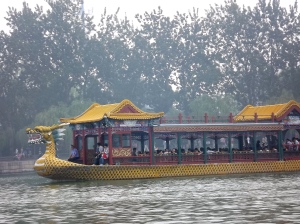 Catching a ride, we arrived at the freshwater pearl factory to learn a bit about this unique type of jewel. The pearls glitter, coming in the classic white, but also twilight purple, peach, and other colors, which made it difficult not to spend too much money purchasing them as gifts! We found a few good deals (and a few not so good, but tough to pass up!), and headed out, this time for Tianamen Square and the Forbidden City.
Catching a ride, we arrived at the freshwater pearl factory to learn a bit about this unique type of jewel. The pearls glitter, coming in the classic white, but also twilight purple, peach, and other colors, which made it difficult not to spend too much money purchasing them as gifts! We found a few good deals (and a few not so good, but tough to pass up!), and headed out, this time for Tianamen Square and the Forbidden City.
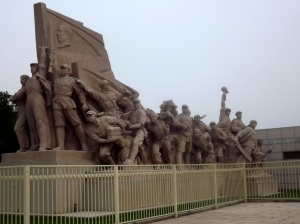 Tianamen Square felt strange to stand in—the infamous photo of 1989 student demonstrations flashed in my mind, contrasting with the cheerful Chinese taking photos with the Monument to the People’s Heroes and the bright red sickle and star celebrating 90 years of Communism in China. It was certainly sobering to stand in the midst of the square, but the crowds and the enthusiasm were a reminder just how different perceptions can be from East to West.
Tianamen Square felt strange to stand in—the infamous photo of 1989 student demonstrations flashed in my mind, contrasting with the cheerful Chinese taking photos with the Monument to the People’s Heroes and the bright red sickle and star celebrating 90 years of Communism in China. It was certainly sobering to stand in the midst of the square, but the crowds and the enthusiasm were a reminder just how different perceptions can be from East to West.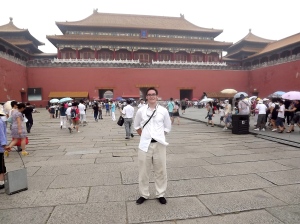
I can see the photo in my mind’s eye—it is difficult with the crowds to picture it, but I am doing my best. My father, in his suit and tie, standing before one of the Forbidden City’s many courtyards…but which is it? I wish I had more of a sense, but the crowds again make it difficult to 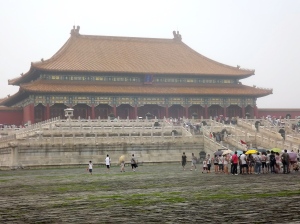 see in my mind’s eye—I eventually settle for 3 different photos, hoping one of them is right. Graceful and overwhelming at the same time, the Forbidden City is famous for its sunflower yellow roofs and ruddy red walls, exemplifying Chinese red for luck, and the yellow for the Emperor. Under the Ming and Qing dynasties, the Forbidden City had been the innermost walled section of Beijing, famous residence of the Emperors and their many entourages. The last
see in my mind’s eye—I eventually settle for 3 different photos, hoping one of them is right. Graceful and overwhelming at the same time, the Forbidden City is famous for its sunflower yellow roofs and ruddy red walls, exemplifying Chinese red for luck, and the yellow for the Emperor. Under the Ming and Qing dynasties, the Forbidden City had been the innermost walled section of Beijing, famous residence of the Emperors and their many entourages. The last 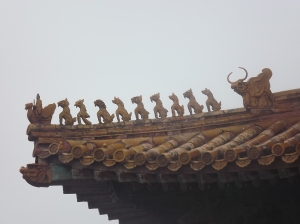 Emperor, Puyi, was confined to the Forbidden City after he was ‘overthrown’ in 1911 and China became a republic.
Emperor, Puyi, was confined to the Forbidden City after he was ‘overthrown’ in 1911 and China became a republic.
Still, many of the buildings do appear similar: a handy trick for telling which are more important: look to the eaves and roofs for the presence of tiny, dog like animals. The more figures, the more important the building, up to 9, the Chinese lucky number. Traveling through the courtyard, we 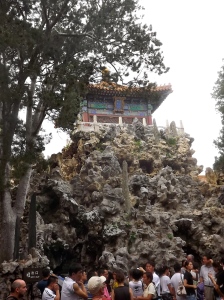 arrive in the Imperial Gardens and see what our Guide calls one of the luckiest places in China—a man-made rock formation that the elderly climb on the 9th of September (doubly lucky), in hopes of longevity. As for the Emperors, they would install stairs to make the climb easier, hoping still for the grace of the Gods!
arrive in the Imperial Gardens and see what our Guide calls one of the luckiest places in China—a man-made rock formation that the elderly climb on the 9th of September (doubly lucky), in hopes of longevity. As for the Emperors, they would install stairs to make the climb easier, hoping still for the grace of the Gods!
In the evening, we went to see a Chinese Acrobatic Show, which was very impressive but eemed more like a variety show, or an episode of ‘China’s Got Talent!’. Some favorites included a clown/fool character that came out into the audience, with straw yellow hair and elaborate makeup, to make and pass out balloon animals, and a group of women who made an inverted pyramid atop a moving bicycle. Tired from our day though, it felt good to finally hit my bed–but I was excited for what would be another full day tomorrow!
